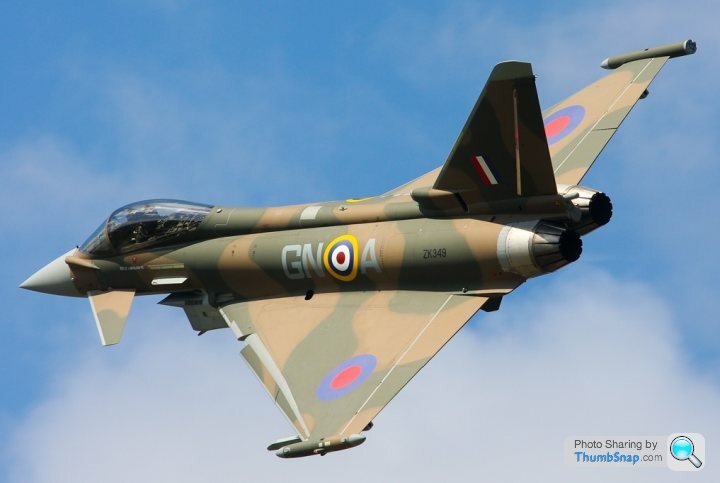Battle of Britain Typhoon
Discussion
Simpo Two said:
Me too...!
But if a certain pattern of camouflage matched the ground in 1940, why doesn't it now? Perhaps we should paint them all with little housing estates on...
Reasonable question actually. Fighters have been multiple shades of grey for years presumably because they are expected to operate at altitude, but ground attack RAF aircraft were painted in green and grey camouflage until very recently.But if a certain pattern of camouflage matched the ground in 1940, why doesn't it now? Perhaps we should paint them all with little housing estates on...
In fact, the camouflage scheme used between 1938 and 1942 was found NOT to be that good. The "Earth" and "Dark Green" upper camouflage scheme was not that effective, especially for aircraft fighting along the coast and the Channel areas.
That's why the fighter scheme was changed to grey and green in 1942. Night bombers retained the earth and green scheme as their upper camouflage was most effective when they were sitting at their bases. They were flying at night so the upper camouflage didn't matter so much on an actual operation.
That's why the fighter scheme was changed to grey and green in 1942. Night bombers retained the earth and green scheme as their upper camouflage was most effective when they were sitting at their bases. They were flying at night so the upper camouflage didn't matter so much on an actual operation.
Dr Jekyll said:
Reasonable question actually. Fighters have been multiple shades of grey for years presumably because they are expected to operate at altitude, but ground attack RAF aircraft were painted in green and grey camouflage until very recently.
The greys schemes started in the late 1970's with the USN 'Ferris Scheme' experiments. The RAF started in the very late 1970s/early 1980s with the work done by Mr Barley at Farnborough (who gives his name to the 'Barley Grey' [later known as 'Camouflage Grey']). The differing greys used were to 'even out' the airframe such that the overall reflectivity matched that of the atmosphere at medium to high level; the 3 tone scheme on the RAF F4s worked particularly well owing to its 'bent wing' nature, but when applied to the Lightning worked less well (and had to be altered) owing to the Lightning's 'slab wing'.
The ground attack a/c (Jaguar, Harrier, Tornado GR) went into the grey schemes with the change in operating parameter from low level to medium level.
A trial was done on Albert with some a/c going grey but this was useless for Tac Ops so was dropped in favour over the later greeny-brown colour.
Interestingly the 'Hemp' schee originally developed for Nimrod, and later applied to the Victors and Funbuses, to help hide them when parked on large concrete dispersals worked particularly well in terms of matching the reflectivity of the upper air. It was less effective at low level over the sea and was dropped for another grey scheme.
Dr Jekyll said:
What was the reasoning behind the green/grey camouflage schemes briefly carried by Lightnings in the early 70s?
It was more a case of bringing the Lightning fleet up to the standard grey/green scheme that the rest of the RAF fleet had already adopted by the late 1960's, as the emphasis become low level ops over high altitude ops (which is why the Lightnings had remained in natural finish until the mid 70's)It was expected that the Lightning was going to be out of service by the mid/late 70's and so hadn't been painted, only the RAFG F.2A fleet being painted o/a green for overland low level ops. But, with the Lightning fleet soldering on past then, the UK fleet were progressively painted as the a/c when through MU's etc.
RAF tactical aircraft were painted with grey/green upper camouflage colours all through the 1950s and into the 1960s. This scheme usually was in gloss or semi-gloss with aluminium painted undersides. You would see these colours on certain Meteors, Vampires, Venoms, Hunters, Javelins and Swifts. In the 60s, the aluminium undersides were replaced by light grey.
In the 1970s, the grey green and light grey changed top matt and the RAF markings had their white elements removed.
In the 1970s, the grey green and light grey changed top matt and the RAF markings had their white elements removed.
el stovey said:

Looks great!
http://www.clavework-graphics.co.uk/aircraft/fanta...
He's got some amazing schemes in there.

Still a targets a target

Anyway, coming back on thread...

More pics & words here:
http://www.globalaviationresource.com/v2/2015/04/2...

More pics & words here:
http://www.globalaviationresource.com/v2/2015/04/2...
Gassing Station | Boats, Planes & Trains | Top of Page | What's New | My Stuff



